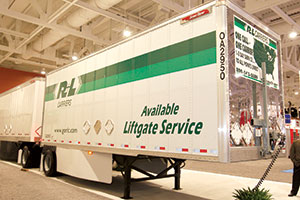Trailer Orders Cool After 4Q Surge, But Still Gain 18% During January

This story appears in the March 2 print edition of Transport Topics.
Orders for new trailers in January slowed after a blistering fourth quarter but still were 18% higher during the month than a year earlier, ACT Research reported.
January’s total of 29,853 was the fifth-highest in the past year and followed a record fourth quarter, in which orders averaged more than 42,000.
“It was a pretty decent number for a January,” said Frank Maly, ACT’s director of commercial vehicle transportation analysis and research. “The way things ended last year, you would anticipate anything was going to be down from a very strong fourth quarter.”
Rhem Wood, an analyst with BB&T Capital Markets in Richmond, Virginia, said: “January wasn’t as good as December, but it was still strong and up year-over-year.”
He told Transport Topics that “trailer orders should remain strong,” though they likely will remain below last year’s record-setting level of almost 360,000.
Trailer orders have gained on a year-over-year basis in 21 of the past 22 months, Wood noted.
Research group FTR reported a slightly lower total of 27,300 orders for January.
“The trailer market remains very vibrant,” said Don Ake, FTR’s vice president of commercial vehicles. “OEMs are finishing up filling third-quarter production, and fleets are optimistic about 2015.”
The industry’s backlog rose to 187,000 units, ACT said, which was up 4% from December and almost double from a year earlier.
The backlog is “certainly the highest in recent history,” Maly said. The last time it was higher was in May 1995 at 194,000. The record was 234,000 in December 1994, he said.
BB&T’s Wood agreed the backlog points to another strong year, and he said that “we may get some legislation . . . that helps demand on the pup-trailer side,” referring to the possibility of Congress allowing 33-foot tandem trailers, up from standard 28-footers.
At eight to 10 years, trailer trade-in cycles are longer than typical three- to five-year truck trade-ins, Wood said.
And “a tremendous amount” of trailers were sold from 1998 to 2000 — about 856,000 — while very few were replaced in the normal trade-cycle time of 2008 to 2010 because of the recession, he added.
“So now you’ve got a really old population of 15- to 17-year-old trailers. In addition to current demand, that could make this cycle last longer than prior cycles,” he said.
Publicly traded Wabash National Corp. said in its recent fourth-quarter earnings report that it shipped 57,350 trailers last year, up 22.5% from 2013.
CEO Dick Giromini said the company’s order backlog climbed to $1.09 billion, equating to about eight months of build volume.
“This certainly supports our long-stated belief that this could turn out to be an extended cycle of strong demand for our industry, driven by excessively aged fleets, demanding regulatory environment . . . and an improved pricing environment for our customers,” he said.
Consistent with ACT and FTR projections, Giromini added: “We believe overall demand for trailers will remain very strong and significantly above replacement levels in 2015 and beyond as key drivers all remain positive.”
Other trailer makers said they were seeing strong demand.
Craig Bennett, Utility Trailer’s senior vice president of sales and marketing, said that “output is at record levels and growing and, while orders are still strong, the backlog will be challenged to stay this long all year.”
Great Dane Trailers sees “continued strength in vans and reefers,” said Chris Hammond, who was promoted to executive vice president of sales last week. “Flatbeds aren’t quite as hot right now, with backlogs only pushing the end of the second quarter.”
Stoughton Trailers, which makes dry vans, said it is enjoying a backlog up 50% year-over-year.
“Orders are solid with our customers,” said David Giesen, vice president of sales and marketing at Stoughton. “Quoting and order-intake volumes remain robust, and it is set to be another good year for trailer producers.”
Hyundai Translead declined to comment.
ACT’s Maly noted there was “some cancellation activity” in refrigerated units and was higher for both liquid and bulk tanks.
“A lot of dealers who were lined up backed away from commitments” for bulk trailers, which are used for carrying fracking sand, Maly said. “It’s a result of the retrenchment that’s going on in the energy sector.”
IHS Automotive, meanwhile, recently reported that U.S. trailer registrations rose to 244,509 last year — an 11% increase from 2013 and the highest annual total since 2006 when it was 284,272.
Vans and reefers represented 71% of all new registrations, IHS said in its quarterly Polk report on commercial vehicles.
Staff Reporter Seth Clevenger contributed to this story.

